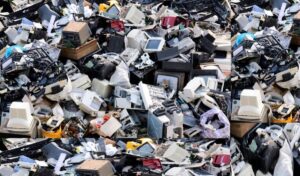80% of Your Tech Turns Toxic! Here’s the Shocking Truth About E-waste
E-waste, or electronic waste, poses a significant global challenge, with 80% of discarded devices ending up in landfills, impacting the environment and human health. Driven by consumer demand for the latest technology, the rapid increase in e-waste has made Asia the largest generator, with a recycling rate of only 17.4%. Health risks associated with e-waste exposure include respiratory issues and adverse birth outcomes. Solutions include comprehensive policies, public awareness, and improved recycling practices. Emphasizing circular thinking can help maximize resource use and minimize waste. A sustainable approach is essential for protecting both the environment and society.

80% of Your Tech Turns Toxic! Here’s the Shocking Truth About E-waste
E-waste, or electronic waste, is an increasingly pressing global issue, with around 80% of discarded electronic devices ending up in landfills. This growing concern not only affects the environment but also poses significant risks to ecosystems, wildlife, and human health. The surge in e-waste is driven by the constant demand for the latest technology, leading consumers to discard older devices, even if they are still functional. Asia is currently the largest generator of e-waste, followed by America, Europe, Africa, and Oceania, with a global recycling rate of merely 17.4%. The World Health Organization (WHO) has linked e-waste exposure to various health issues, including premature births and respiratory problems.
To address this crisis, we need comprehensive policies, public awareness initiatives, and improved recycling infrastructure. Furthermore, many electronic products are designed for shorter lifecycles due to planned obsolescence, which exacerbates the problem. While recycling is preferable to landfilling, some processes can be energy-intensive and contribute to greenhouse gas emissions. Emphasizing circular thinking can help us transform waste into valuable resources, promoting a sustainable future that minimizes waste and maximizes resource use.
The Growing Concern of E-waste
In today’s globalized society, electronic waste (e-waste) has become an increasingly urgent issue. E-waste refers to discarded electronic devices that are no longer wanted, malfunctioning, or have reached the end of their useful life. This problem extends beyond the tech industry and affects everyone. Alarmingly, 80% of electronic products are discarded in landfills. While recycling is a positive action, it’s essential to prioritize safety and responsible handling practices to prevent environmental damage.
Environmental Risks of E-waste
E-waste poses significant environmental hazards, affecting ecosystems, wildlife, and human health in various ways. Studies indicate that the rapid rise in e-waste is fueled by an insatiable demand for new technology. Continuous advancements lead to the frequent release of new electronic models, and consumers’ desire for the latest devices often results in the disposal of older, still functional ones.
This trend includes the regular discarding of small appliances like microwaves, toasters, mobile phones, laptops, computers, printers, and televisions, as well as larger items such as washing machines, dishwashers, and refrigerators. Consequently, Asia has become the largest generator of e-waste, followed by America, Europe, Africa, and Oceania, with a global recycling rate of only 17.4%.
According to the World Health Organization (WHO), exposure to e-waste can result in various adverse health effects, including negative birth outcomes such as premature births, lung function changes, and respiratory problems. These challenges continue to grow over time.
Solutions for a Greener Future
Today, many electronic products have shorter lifecycles due to planned obsolescence, where manufacturers intentionally shorten product lifespan to encourage repeat purchases. Improper disposal of e-waste leads to habitat destruction, disrupting local wildlife habitats and causing biodiversity loss. In some regions, inadequate regulations and enforcement exacerbate improper e-waste management practices, compounded by a lack of Extended Producer Responsibility (EPR) policies that hold manufacturers accountable for end-of-life product management.
To combat these issues, comprehensive policies, public awareness campaigns, and improved recycling infrastructure are essential for mitigating the growing e-waste problem and promoting sustainable consumption and disposal practices. By addressing the environmental risks associated with e-waste, we can implement safer management practices that protect both the environment and public health.
While recycling e-waste is generally better than landfilling, some recycling processes are energy-intensive and contribute to greenhouse gas emissions. Improving recycling technologies and processes can help reduce this impact.
Embracing Circular Thinking
Adopting circular thinking can transform waste into opportunity, paving the way for a greener future where resources are maximized and waste is minimized. It is crucial to shift away from a linear mindset and strive towards a sustainable approach that benefits both the environment and society, one step at a time.
Check out TimesWordle.com for all the latest news
You must be logged in to post a comment.